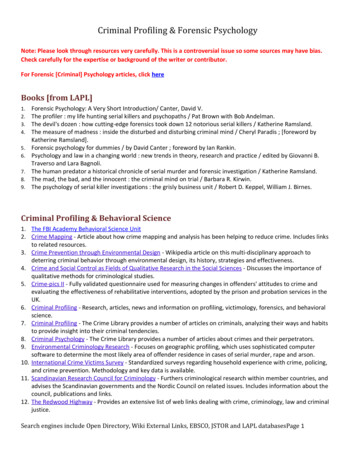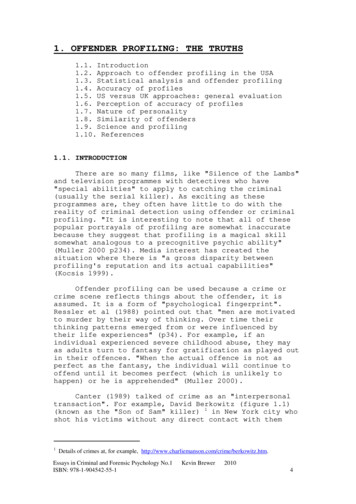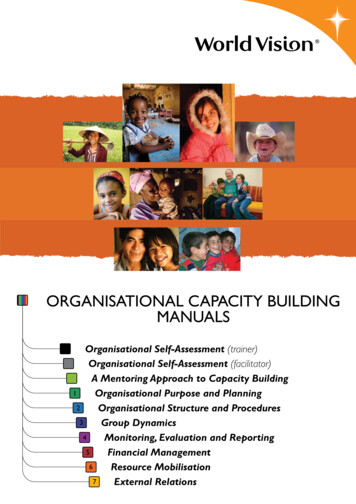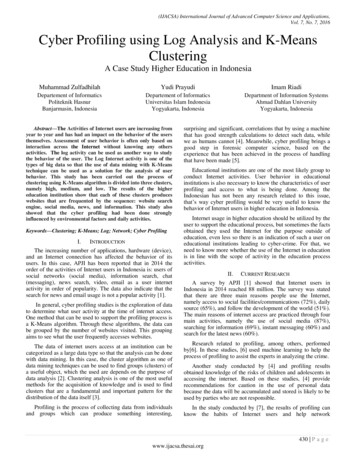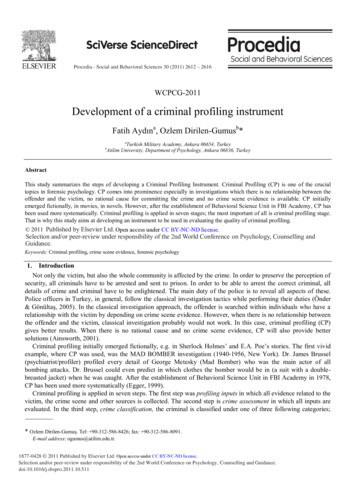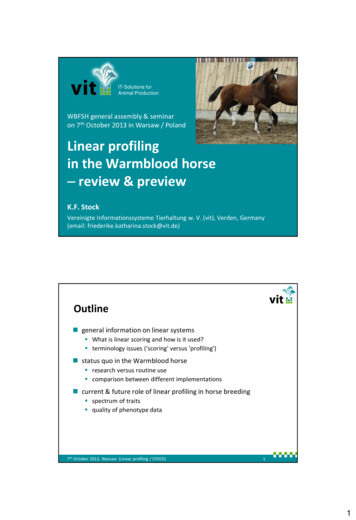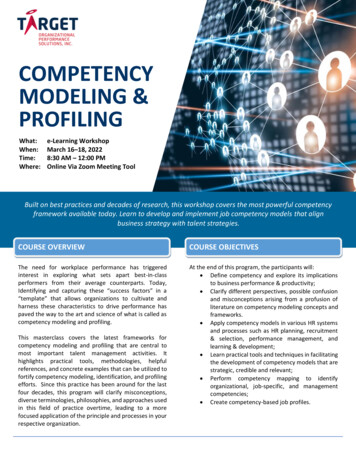
Transcription
IRJA-Indian Research Journal, Volume: 1, Series: 4. Issue: September, 2014Online Available at www.indianresearchjournal.comISSN: 2347-7695PROFILING OF ORGANISATIONAL CULTURE USING OCTAPACE FRAMEWORK INPONNI SUGARS ERODE PVT LTDM.JayanthiAssistant Professor in Commerce, KSR College of Arts and Science (Autonomous)M.BhuvaneshwariM.Phil Scholar in Commerce, KSR College of Arts and Science (Autonomous)Abstract:The present study has attempted to probe the dynamics of organisational culture in PnniSugars Erode Pvt limited by using OCTAPACE framework. The emprical studies in the past revealedthat conducive OCTAPACE culture is a necessary precondition for influencing organisationaleffectiveness positively. The study conducted the descriptive research by framining a well structuredquestionnarie. The respondents became the employees ranging from different departments in theponni ugars Erode Pvt LTd.,Out of 220 questionnaries distributed only 200 were returned completedin all respects. The study was conducted with a response of 90% which can be considered reasonablygood in light of past studies as well as in behavioural researches. The achieve the objectives, 200responses were evaluated on a 5-point scale of an OCTAPACE profile with 8 values of Openness,Confronttion, Trust,Authenticity,Proaction, Autonomy, Collabration and Experimentation. Theprimary data are collected by administering the well-structured questionnaire, to the respondentsdirectly and collected the information from them. As the question generate direct information the datawere analyzed using Statistical tools such as Percentage analysis, Rank correlation, and ANOVA .The implication of the findings and possible directions for further research are discussed.Key Words: Organisation Culture, Involvement, Autonomy, Confrontation, HRD Climate,Openness, Satisfaction.INTRODUCTION:A culture with OCTAPACE values has the greater chance of achieving high involvement andsatisfaction, team work, growth and free flow of communication within the organization. If we needmore about the organization culture with the help of the instrument OCTAPACE. Each alphabetstands for a particular dimension or value. Another explanation to the term: An optimum level of“Development Climate” is essential for facilitating HRD. Such a climate is characterized asconsisting of the following characteristics i.e. known as OCTAPACE. OCTAPACE also representsEIGHT HRD values; „The eight HRD values, viz. OCTAPACE values (Openness, Trust, Pro-action,Confrontation, Collaboration, Authenticity, Autonomy, and Experimentation), give a sense ofdirection to the HRD function.At present the sugar industries are facing many problems, like labor problems insufficientsugarcane problems because of no proper rainfall are some of the problems faced by sugar industry,India‟s sugar sector faces a fall in prices, rising raw material cost, limited export capacity and etc.,because of above said problem low sugar cane production. Industries are affected and sugarproduction cost is increases. So they earn low profit.
IRJA-Indian Research Journal, Volume: 1, Series: 4. Issue: September, 2014Online Available at www.indianresearchjournal.comISSN: 2347-7695A research problem in general, refers to some difficulty which a researcher experiences in thecontacts of either a theoretical or practical situation and once to obtain a solution for the same. Aproblem well defined is half solved. The research problem is to study the profiling of organizationalculture using OCTAPACE framework in PONNI SUGARS (ERODE) LTD.OCTAPACE CULTURE:Organization Culture as “ A pattern of shared basic assumptions that the group learnedas it solved its problems of external adaptation and internal integration that has worked well enoughto be considered valid and, therefore, to be taught to new members as the correct way to perceive,think , and feel in relation to those problems”.HISTORY OF THE COMPANY:Scheme sanctioned by the Hon‟ble High Court of Madras on 10th September 2001. In termsof the Scheme, the company took over the business of Erode Undertaking with concurrent transfer ofmajor part of stakeholders‟ interest in PSCL (Ponni sugars and chemicals Ltd) to the company.The Erode sugar mill was set up with 1250 TCD capacity in 1984 in a record time of 12months. It achieved full capacity crushing during the very first year of its commercial operation thatenabled declaration of a maiden dividend of 10% in that very first year, a record in the annals of sugarindustry. It was a trendsetter in mobilizing surplus cane during its infancy stage from neighboringsugar mills and extending crushing season to well above industry average. Its capacity was expandedto 2500 TCD in 1994.The Erode sugar mill has successfully implemented an innovative Lift Irrigation Scheme bybringing in dry lands under cane cultivation, utilizing the effluent discharge of the neighboring papermill. This has helped secure many benefits – providing a dependable and perennial source ofirrigation to farmers in the neighborhood, increase of land value manifold in the region, transformingthe livelihood of local rural population, resolving the raw material needs of sugar and paper mills andaddressing ecological concerns in effluent discharge.Right at its inception, Ponni was structured on the concept of total diversion of biogases forpaper. Accordingly it installed a coal fired boiler and later added a multi fuel boiler in place ofconventional biases fired boilers. It has a Bagasse tie up arrangement with Seshasayee Paper andBoards Ltd for a mutually beneficial and rewarding long term relationship.Ponni is an efficient and quality producer of sugar, catering to both domestic and internationalmarkets. It is a venerable partner for villagers growing sugarcane in its neighborhood. It enjoyscordial relationship with employees. It firmly believes in transparent and fair dealings with all itsstakeholders by following sound corporate governance norms both in letter and spirit.SCOPE OF THE STUDY:This study focus on today‟s turbulent, often chaotic, environment commercial successdepends on employees making use of their talents in full. The management can create the workenvironment in which their employees will thrive. This study will help the management to enhancethe professional perception of the employees. The organization can identify the relationship existingbetween the superiors and subordinates. It encourage the resolve of the employees to change thenegative behavior patternOBJECTIVES OF THE STUDY:
IRJA-Indian Research Journal, Volume: 1, Series: 4. Issue: September, 2014Online Available at www.indianresearchjournal.comISSN: 2347-7695To determine the outlook of employees towards proactive and innovative measures taken bythe management.To identify as well as measure the values and belief of the employees pertaining to theOCTAPACE culture of their organizations.REVIEWOF LITERATURE:Neeraj kumari (2013), “A study on the OCTAPACE culture of an organization”, in his studyfocuses that the overall HRD Climate of Spanco is encouraging. There is a keen interest of topmanagement in HRD and there is a high team spirit and employees take training seriously. The studyconcludes that Spanco also needs to focus on staff for the motivation since OCTAPACE perceived bythis level is comparatively low.Mu.Subrahmanian and P.Renganathan (2013), “Employee‟s perspective towards organizationculture in Automobile Industries in Chennai”, In this study the researcher has made an attempt tostudy the employee‟s intuitivism towards existing Organization culture and practices at automobilecompanies for which the researcher set objectives based on dimensions of Organization culture andmade use of OCTAPACE tool depend and customized it according to the requirement of theorganization based upon which the questionnaire were constructed. In his study concluded that theemployee‟s expectations needs to be bridged with the organization culture for which researcher hasput forth few valuable suggestions for consideration of the management.Kliuchnikov, A., (2011) “Leader‟s Authenticity Influence on Followers” OrganizationalCommitment: the present study examines the organizational commitment. The result indicate that apositive and significant relationship exists between authentic leadership and affective organizationalcommitment.Sanjeev K.Sharma and Aditi Sharma (2010), “Examining the Relationship between organizationalculture and Leadership Styles”, Present Study reflects the presence of strong value based culture inthe organizations under study. Results of the study on textile industry in North India show a Positiveassociation between culture values and Charismatic leadership Styles. Organizational cultureexhibiting characteristics of accountability, Collaboration, Decentralized leadership, alignment andadaptability hold the key to successful survival.Adam, Sharon and Catherine (2009), “Role of employee proactivity”, this study focuses that thedimension of proactivity. It is suggested that proactive behaviors are more likely to contribute tohigher supervisor performance evaluations when employees express strong prosaically values or lownegative affect.Feza Tabassum Azmi and Richa Sharma (2007), “Profiling OCTAPACE culture: An empiricalstudy of banking and IT sectors in India”, the study focuses that the comparing the organizationalculture of companies in the IT and Banking sectors in India using OCTAPACE profile. The studysuggests that the mean score of IT companies on openness, proaction, and experimentation havehigher values, whereas the banking sectors.Nahrgang & Morgeson (2007) the present study focuses that the Job autonomy is capable ofstimulating high levels of commitment to organization. This study concludes that perceived jobautonomy is positively related to important work outcomes, including organizational commitment.
IRJA-Indian Research Journal, Volume: 1, Series: 4. Issue: September, 2014Online Available at www.indianresearchjournal.comISSN: 2347-7695Gurkoo & Mufeed (2007), “Need to focus on key elements of OCTAPACE Culture in UniversitiesAn Empirical Assessment”, the study have conducted comparative study in Universities of Jammu &Kashmir with sample of 521 employees about perception of teaching & non- teaching staff towardsHRD climate in universities. And this study concludes that the value of pro-activity as unfavorable.Eelke De Jonget. al. (2006), “Culture and Openness”, in their study showed that there indeed exits arelationship between different dimensions of culture and openness. The researchers foundindividualism to have a positive effect on openness and uncertainty avoidance to have negative effecton openness.Pollitt’s (2005), “Diversity is About More Than Observing the Letter of the Law”, the studyexamines that Organizational culture works as a catalyst for employee‟s commitment towards theirorganization. The study concludes that organizational culture is the strongest strategic lever increating an engaged and committed workforce.Rainayee (2002), “HRD Climate in Commercial Banks: An Empirical study”, in a study of HRDclimate in commercial banks found that the overall level of OCTAPACE values. This studyconcluded in the banks was perceived at a moderate level.Rao, Raju and Yadav, (2001), “A Study of HRD Concepts, Structure Departments and HRDPractices in India”, in their study surveyed HRD practices in 12 Indian organizations coveringfinancial services, consumer products, electronics, cement, tyers and automobiles. The results showsthat the employees perceived as favorable the value of autonomy.Mangaraj (1999), “HRD system a case study of Rourkela Steel plant”, in her study focuses that thesystem of the HRD in RSP. It is concluded that employee‟s opportunities to express their view pointsare quite successful.Patel, (1999), “HRD Climate: A Comparative study among two ends of performance”, the presentstudy shows that a comparative study of 20 branches , using 105 employees from 10 high performingbranches and 10 low performing branches were selected, the study concluded that trust recordedabove average.Shakeel (1999), “HRD in Universities”, the present study examines the research study on humanresources development in universities, this study concludes that the existing level of OCAPACECulture at a low degree.RESEARCH DESIGN:A Research design is simply the framework or plan for the study that guides the collection andanalysis of data. The type of research design used in this study is descriptive research. It describesdata and characteristics about the population. The study is confined in ERODE city. The universe ofthe study consists of employees of Ponni Sugars Erode LTD with a total number of 325. Out of thetotal population data could be collected from 200 employees. The research instrument used isQuestionnaire. Close Ended Questions were used to get the opinion from the respondents. As thequestion generate direct information the data were analyzed using Statistical tools such as, Percentageanalysis, Rank correlation, Chi-square , T-tes and ANOVALIMITATION OF THE STUDY:
IRJA-Indian Research Journal, Volume: 1, Series: 4. Issue: September, 2014Online Available at www.indianresearchjournal.comISSN: 2347-7695The attitude of the employee changes from time to time, hence the results of the study may beapplicable only at present. It is tough to collect the exact information because some of the employeesare reluctant to share their information. It is difficult to elicit responses from employees who do nightshifts.DATA ANALYSIS AND INTERPRETATIONS:DEMOGRAPHIC PROFILE OF THE EMPLOYEESEmployees „demography is the study of the composition of a social entity in terms of itsmembers‟ attributes. Demographics would include such factors as age, gender, marital status,education qualification, number of dependents, monthly income, and span of service. The researcherwould normally include those factors which are assumed to have explanatory value in the research.DemographicFactorsGENDERAGEMARITAL STATUSACADEMICQUALIFICATIONDESIGNATIONTable No.1Demographic Profile of RespondentsDescriptionsNo of RespondentsMalePercentage19999.5Female1.5Below 25 Years189.025 - 35 Years6030.035 - 45 Years8844.045 - 55 Years2211.0Above 55 Years126.0Below 25 mer105.0Manager2010.0Clerical2010.0
IRJA-Indian Research Journal, Volume: 1, Series: 4. Issue: September, 2014Online Available at ONTHLYINCOMENATURE OF JOBSOURCES OFINCOMEISSN: Less than 5 Years3316.55 - 10 Years4522.510 -15 Years6733.515 - 20 Years3115.5Above 20 Years2412.0Below Rs.10,0002914.5Rs.10,000 - Rs.15,0006432.0Rs.15,000 - Rs.20,0008241.0Rs.20,000 - Rs.25,000157.5Above act Basis178.5Others94.5Interest on Deposit8643.0Income on Asset6030.0Spouse Salary4422.0Others105.0
IRJA-Indian Research Journal, Volume: 1, Series: 4. Issue: September, 2014Online Available at www.indianresearchjournal.comISSN: 2347-7695Source: Primary DataFrom the above table, consisted of 99.5 percent male and 0.5 percent female. Hence, it wasobserved that the majority of the employees were male respondents. It was alleged that 44.0 percentof employees were in the age group of 35-45years and 6.0 percent of the employees were belongingto above 51 years of age. The marital status wise classification of the respondents depicted that, 87.5percent of the employees were married and 12.5 percent of them were Single. It was inferred that 32.0percent of the employees are Graduates and the lowest academic qualification of employees are only8.0 percent. It is evident that 50 percent of the respondents are workers of the organization next 30percent is of manager, clerk and officer with equal proportion, 15 percent staff members and 5percent programmers were in the organization. The highest proportion is 27.0 percent of theemployees are belonging to Engineering and the lowest proportion is 6.0 percent of the employees arebelonging to Cane department. It is clearly states that the majority of the respondents (33.5 percent)who have 10-15 years experiences and 12.0 percent of the employees are belonging to above 20years. It is clearly evident that most of the respondents are belong to the income group ofRs.15, 000 –Rs.20, 000 and only 5.0 percent of the employees who get Above Rs.25,000. The Majority of therespondents are belong to permanent job and 10.5 percent of the employees belongs to the nature oftemporary job. It is clear that the table shows 43.0 percent of the employees additional income isinterest on deposits, 30.0 percent of the employee‟s additional income is income on asset, 22.0percent of the employees additional income is spouse salary, and 5.0 percent of the employeesadditional income is related to others. Hence it is clearly states that majority of the respondents haveinterest on deposits.RELATIONSHIP AMONG THE FACTORS OF EMPLOYEES BEHAVIOUR ONOCTAPACE CULTUREThe relationship among various factors of Employees Behavior on OCTAPACE Culture hasbeen established to make this study more meaningful. The combination of these factors is consideredas the major influencing factor among the employees behavior towards Organizational Culture. Inthis regard, Spearman‟s rank coefficient of correlation is employed to find out the inter-relationshipamong the factors of Employees Behavior on OCTAPACE Culture.Table No. 2RELATIONSHIP AMONG THE FACTORS OF EMPLOYEES BEHAVIOUR ONOCTAPACE 3224Rank6 0232723
IRJA-Indian Research Journal, Volume: 1, Series: 4. Issue: September, 2014Online Available at www.indianresearchjournal.comISSN: 2347-7695The rank correlation results indicated that the first factor „Openness‟ positively correlatedwith Confrontation and Trust, the spearman rank correlation P 0.123, 0.061. „Openness‟ negativelycorrelated with Authenticity, Proaction, Autonomy, Collaboration, and Experimentation, thespearman rank correlation P -.199, -.238, -.358, -.216, -.176. The second factor „confrontation‟positively correlated with Authenticity, the spearman rank correlation P .220. Confrontationnegatively correlated with Trust, Proaction, Autonomy, Collaboration, and Experimentation thespearman rank correlation P -.028, -.209, -.252, -.410, -.399. The third factor „Trust‟ negativelycorrelated with Authenticity, Proaction, Autonomy, Collaboration, Experimentation the spearmanrank correlation P -.090, -.016, -.382, -.285, -.247. The fourth factor „Authenticity‟ negativelycorrelated with Proaction, Autonomy, Collaboration, and Experimentationthespearman rankcorrelation P -.236, -.136, -.243, -.200. The fifth factor Proaction positively correlated withAutonomy thespearman rank correlation P .025, Proaction negatively correlated with Collaborationand Experimentation thespearman rank correlation P -.052, -.258. The Sixth factors „Autonomy‟positively correlated with Collaboration and Experimentation the spearman rank correlation P .081,.046. The Seventh factors „Collaboration‟ positively correlated with Experimentation the spearmanrank correlation P .177.Hence it is concluded that the relationship between Confrontation andAuthenticity is highly positive correlated P 0.220.ASSOCIATION BETWEEN CULTURE PRIORITY AND CULTURE VALUEChi Square test is applied in statistics to test the goodness of fit to verify the distribution ofobserved data with assumed theoretical distribution. Therefore, it is a measure to study the divergenceof actual and expected frequencies. The null hypothesis was framed to test the cultural priority andcultural values such as “There is no significance difference between Culture dictates priority toestablish and Culture value has strong impact on behavior of the persons”.Table No. 3Culture Priority and Culture ValueVariablesYesNoTotalCulture Dictates Priority to Establish16436200Culture Value have Strong Impact on 92Behavior of the Persons.108200Total144400256Table No. 3.1Association between Culture Priority and Culture ValueTestsValuedfSig.Pearson Chi-Square56.250 1.000Likelihood Ratio58.200 1.000Linear-by-Linear56.109 1.000Association
IRJA-Indian Research Journal, Volume: 1, Series: 4. Issue: September, 2014Online Available at www.indianresearchjournal.comISSN: 2347-7695The chi-square test indicated that the Pearson Chi-square calculated Pvalue 0.000. The valueis highly significant. which is less than 5% level of significant. Hence, the null hypothesis is rejected.Therefore, it is concluded that there is an association found between Culture priority and Culture havestrong impact.INFLUENCES OF EMPLOYEES BEHAVIOR AND OCTAPACE CULTUREThe eight dimensions of organizational culture, such as openness, confrontations, trust,authenticity, proaction, autonomy, collaboration, experimentation as identified, on employees‟behavior have been analyzed to measure their influences. One way Analysis of variance (ANOVA) isapplied to find out the influences of employees behavior and OCTAPACE culture.Ho:“There is no significance difference between employees’ behavior and OCTAPACE culture”Table No. 4EMPLOYEES BEHAVIOR AND OCTAPACE n GroupsTotalBetweenGroupsWithin GroupsTotalBetweenGroupsWithin GroupsTotalBetweenGroupsWithin GroupsTotalBetweenGroupsWithin GroupsTotalBetweenGroupsWithin GroupsTotalBetweenGroupsWithin GroupsSum 008.00013.615.308.9052.00012.000
IRJA-Indian Research Journal, Volume: 1, Series: 4. Issue: September, 2014Online Available at kTotalBetweenGroupsWithin ISSN: 2347-76951.688.371The ANOVA results divulges that the Factors, that the OCTAPACE and Feedback value iscomparatively highly positive. Since the calculated „P‟ value is greater than the 0.05 level ofsignificant. Hence accept the null hypothesis. There is no significance difference between EmployeesBehavior on OCTAPACE Culture.CONCLUSION:Culture is a process of "sense-making" in organizations. Sense-making has been defined as "acollaborative process of creating shared awareness and understanding out of different individuals'perspectives and varied interests." Note that this moves the definition of culture beyond patterns ofbehaviour into the realm of jointly-held beliefs and interpretations about "what is." It says that acrucial purpose of culture is to help orient its members to "reality" in ways that provide a basis foralignment of purpose and shared action. The present study focuses that the overall OCTAPACEculture in the organization under study seems to be above average with 60.06%. As far as dimensionsof OCTAPACE are concerned, collaboration ranked first amongst the ethos of organization culture,following authenticity, autonomy, trust, pro-activity, openness and confrontation. In comparison tothe dimensions of OCTAPACE confrontation ranked lowest.REFERENCES:1. Adam, Sharon, Catherine, (2009)"Role of employee proactivity, Academy of Managementjournal, 54 (3), pp. 528–550.2. Alphonsa, V.K, Sr., (2000), HRD Climate in a Private Hospital in Hyderabad-An EmpiricalStudy, IJTD, Vol.XXX (4) Oct –Dec.3. Monish Kumar (2013), Effect of leadership behaviors on knowledge creation in IndianOrganizations, Delhi Business Review X Vol. 14, No. 2 (July - December 2013).4. Carole V. Wells, David Kipins, (2001), “Trust, Dependency, and Control in the ContemporaryOrganizational”, Journal of Business and Psychology, 15(4), pp.593-603.5. Hersey, P.,Balanchard, K.,& Johnson, D.(2000) Management of Organizational Behavior:leading human resouces. Upper Saddle River, NY: Prentice-Hall.6. Eelke De Jong, Roger Smeets, Jeroen Smits, (2006) “Culture and Openness”, SocialIndicators Research, 78 (1), pp.111-136,7. Feza Tabassum Azmi and Richa Sharma, (2007) Profiling OCTAPACE culture: An empiricalstudy of banking and IT sectors in India”, The Icfaian Journal of Management Research, VolVI, www.iupindia.org. December 20078. Fiol, C.M., & Lyles, M.A. (1985), Organizational learning, Academy of Management Review,Vol.10 (4): 803-813.
IRJA-Indian Research Journal, Volume: 1, Series: 4. Issue: September, 2014Online Available at www.indianresearchjournal.comISSN: 2347-76959. Ferres, N.; Connell, J., and Travaglione, A., (2004). “Co-worker Trust as a Social Catalyst forConstructive Employee Attitudes”, Journal of Managerial Psychology, Volume: 19(6), pp.608-622.10. Gurkoo & Mufeed S.A (2007), Need to focus on key elements of OCTAPACE Culture inUniversities-An Empirical Assessment, The journal Contemporary management ResearchTiruchirappalli PP-28-51.11. .Mughees Uddin Siddiqui (2013), “Perceptual Mapping of Private and Government DoctorsAs Regards to Organizational Values: A Comparative Study”, International journal ofmanagement research and business strategy, Issue No-4, Volume-2, ISSN 2319-345X.12. Dr. Sharma Ritual (2014), “Organizational Values & Employee Performance”, ZENITHInternational Journal of Business Economics & Management Research, Issue 3, Volume:4,OnlineISSN:2249-8826.pp.172-178.13. Lok, P., and Crawford, J., (1999). “The Relationship between Commitment andOrganizational Culture, Subculture, Leadership Style and Job Satisfaction in OrganizationalChange and Development”, Leadership and Organization Development Journal, Volume:20(7), pp. 365-373.14. Pollitt, D., (2005). “Diversity is About More Than Observing the Letter of the Law”, HumanResource Management International Digest, Volume: 13(4), pp. 37-40.15. Kliuchnikov, A., (2011). “Leader‟s Authenticity Influence on Followers‟ OrganizationalCommitment, Emerging Leadership Journeys”, Volume: 4(1), pp. 70-90.16. Shivani Raval (2014), “Organizational Cultures: Hospitality v/s Banking A Detailed Study onthe Contrasting Sectors”, International Journal of Conceptions on Management and SocialSciences Vol. 2, Issue. 2, May‟ 2014; ISSN: 2357 – 2787, pp.48-54.17. Panchamia, Jallavi (2013), “A Study of OCTAPACE Culture in Civil Hospital, Gandhinagar”,IUP Journal of Organizational Behavior; Apr2013, Vol. 12 Issue 2, p43.18. Neeraj kumari (2013), “A study on the OCTAPACE culture of an organization”, Open Journalof Social science Research, Issue 10.12966, March 2013, Volume 1(8), pp. 211-225.19. Dr. Nirmala chaudhary (2011), “HRD CLIMATE AND JOB SATISFACTION: An EmpiricalInvestigation”, International Journal of Computing and Business Research, Issue 2 May 2011,ISSN (Online) : 2229-6166 ,Volume 2,20. Muna Kalyani (2011) “Innovative Culture: An Intervention Strategy for Sustainable Growthin Changing Scenario”, International Journal of Business Administration, ISSN 19234007(Print) ISSN 1923-4015(Online), Vol 2, No 4, p.84.21. Mohammad Hassan Jafri., (2012). of Retailing & Rural Business Perspectives PezzottaiteJournals, Volume 1, Number 2, “An empirical study of OCTAPACE culture andorganizational commitment”, International Journal October-December‟ 2012, ISSN (P):22790934, (O):2279-0942, pp.187-194.22. Dr.MU.Subrahmanian (2012), “Achieving high involvement & satisfaction throughOCTAPACE culture in it companies”, Zenith International Journal of Business Economics &Management Research, Vol.2 Issue 5, May 2012, ISSN 2249 -8826 ,pp.131-138.23. Mu.Subrahmanian and P.Renganathan (2013), “Employee‟s perspective towards organizationculture in Automobile Industries in Chennai”, Issue 1, January 201324. Sapna Rijal, Purbanchal University, Nepal (2010) Leadership Style And OrganizationalCulture In Learning Organization: A Comparative Study, International Journal of
IRJA-Indian Research Journal, Volume: 1, Series: 4. Issue: September, 2014Online Available at www.indianresearchjournal.comISSN: 2347-7695Management & Information Systems – Fourth Quarter 2010 Volume 14, Number 5,pp.119128.25. Sanjeev K.Sharma and Aditi Sharma (2010), “examining the Relationship betweenorganizational culture and Leadership Styles”, Journal of the Indian Academy of AppliedPsychology, Issue 1, January 2010, Volume.36, pp.97-105.26. M. Srimannarayana, (2008)"Human Resource Development in India", Indian Journal ofIndustrial Relations, 44(2), pp. 248-255.27. Mufeed S.A (2006) The need for a focus on key elements of HRD climate in Hospitals- anEmpirical study, Management of Labour Studies XLRI, Jamshedpur Vol. 31 PP 57-65.28. Mufeed, S.A., (2006), Enhancing Educational Institutions Effectiveness through HRDclimate: An Empirical Study, Management and Change, Vol. 10 N2 PP 25-64.29. Mattoo A R and Ahmad M P (2005), HRD Climate in the Hospital of J and K state andEmpirical Study”, The Business Review, Vol. 11, No. 2.30. B. K .Punia and Luxmi (2005), “Organizational culture in service sector: An exploration”,Delhi Business Review, X Vol. 6, No. 1 (January - June 2005), pp.45-51. .
Sanjeev K.Sharma and Aditi Sharma (2010), "Examining the Relationship between organizational culture and Leadership Styles", Present Study reflects the presence of strong value based culture in the organizations under study. Results of the study on textile industry in North India show a Positive

